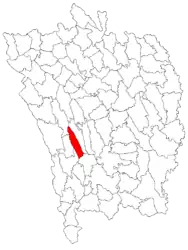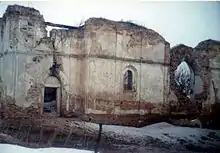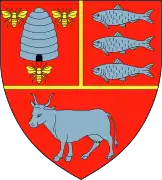Ibănești, Vaslui
Ibănești is a commune located in Vaslui County, Western Moldavia, Romania, with a population of approximately 1,500. It is composed of three villages: Ibănești, Mânzați and Puțu Olarului.
Ibănești | |
|---|---|
 Location in Vaslui County | |
 Ibănești Location in Romania | |
| Coordinates: 46°23′48″N 27°37′27″E | |
| Country | |
| County | Vaslui |
| Established | 1434 |
| Government | |
| • Mayor | Benone Pleta |
| Population (2011)[1] | 1,451 |
| Time zone | EET/EEST (UTC+2/+3) |
| Vehicle reg. | VS |
| Website | www |
History
Among the villages that make up the commune, Mânzați is the oldest. Located seven miles from Ibănești, it was named after cneaz Toader Manzat, mentioned in chronicles of Stephen III the Great. It was first mentioned in a document issued April 24, 1434. Currently, the act is kept in the Central State Archive of Warsaw, in a section on Moldova.
Ibănești Commune was dissolved in 1968. At the time, it included Ghicani village, now part of Alexandru Vlahuță, to which Ibănești Commune was then absorbed. It was re-established in December 2003.
Sites

Mânzați village features the ruins of a church built around 1761, restored in 1910 and demolished after 1940.
In 1889, on land near Mânzați, researcher Grigore Ștefănescu discovered the fossilized skeleton of a Mammoth from the species Deinotherium gigantissimum. The fossil, belonging to a juvenile, is 4.5 m high and 3.5 m long. It is exhibited at Bucharest's Grigore Antipa National Museum of Natural History, mounted in 1906 by Belgian restorer L. F. de Pauw. This copy is now one of the most important displays at the museum. In 2005, the land where it was discovered was declared a paleontological subject of national interest.
Residents
- Constantin Chiriță, writer, born March 12, 1925, died November 14, 1991
See also
- "Populaţia stabilă pe judeţe, municipii, oraşe şi localităti componenete la RPL_2011" (in Romanian). National Institute of Statistics. Retrieved 4 February 2014.
